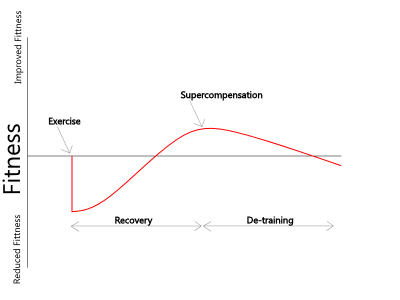Training Monotony
It is long been recognized the athletes cannot train hard every day. Modern training plans recommend a few hard days per week, with the other days as easier or rest days. A lack of variety in training stress, known as training monotony, is considered a key factor in causing overtraining[1][2]. There is also evidence[3] that increased training frequency results in reduced performance benefits from identical training sessions as well as increased fatigue.
Contents
1 Training Monotony and Supercompensation
Training Monotony is related to Supercompensation and the need for adequate rest to recover from training.
2 Quantifying monotony
One approach[4] to measuring monotony is statistically analyze the variation in workouts. The first stage is to work out a measure of the daily TRIMP (TRaining IMPulse). From this daily TRIMP it's possible to calculate the standard deviation for each 7 day period. The relationship between the daily average TRIMP value and the standard deviation can provide a metric for monotony. The monotony value combined with the overall training level can be used to evaluate the likelihood of overtraining.
3 Monotony Calculations
The original work[4] on training monotony used TRIMPcr10 and TRIMPzone, but I substitute TRIMPexp for TRIMPzone because of the advantages noted in TRIMP. From the daily TRIMP values for a given 7 day period the standard deviation can be calculated. (If there is more than one workout in a day, the TRIMP values for each are simply added together.) The monotony can be calculated using
Monotony = average(TRIMP)/stddev(TRIMP)
This gives a value of monotony that tends towards infinity as stddev(TRIMP) tends towards zero, so I cap Monotony to a maximum value of 10. Without this cap, the value tends to be unreasonably sensitive to high levels of monotony. Values of Monotony over 2.0 are generally considered too high, and values below 1.5 are preferable. A high value for Monotony indicates that the training program is ineffective. This could be because the athlete is doing a low level of training; an extreme example would be a well-trained runner doing a single easy mile every day. This would allow for complete recovery, but would not provide the stimulus for improvement and would likely lead to rapid detraining. At the other extreme, doing a hard work out every day would be monotonous and not allow sufficient time to recover. The Training Strain below can help determine the difference between monotonous training that is inadequate and monotonous training that is excessive.
4 Training Strain Calculations
A similar calculation can be used to calculate a value for Training Strain.
Training Strain = sum(TRIMP) * Monotony
The value of Training Strain that leads to actual overtraining would be specific to each athlete. An elite level athlete will be able to train up much higher levels than a beginner. However this Training Strain provides a better metric of the overall stress that an athlete is undergoing than simply looking at training volume.
5 A simple TRIMPcr10 based calculator
This calculator will show the TRIMPcr10 values for each day, the Monotony, the total TRIMPcr10 for the week and the Training Strain.
6 TRIMPexp Examples
For these examples we will use just a few simple workouts. Let's assume a male athlete with a Maximum Heart Rate of 180 and a Resting Heart Rate of 40, giving a Heart Rate Reserve of 140. Let's assume our hypothetical athlete does his easy runs at a 9 min/mile pace and heart rate of 130. We'll use only one of the type of workout, a tempo run his easy runs at a 7 min/mile pace and heart rate of 160. This gives us some TRIMPexp values for some workouts
| Type | Miles | Name | Duration | TRIMPexp |
|---|---|---|---|---|
| Easy | 4 | Easy 4 | 36 | 11,132 |
| Easy | 6 | Easy 6 | 54 | 16,699 |
| Easy | 10 | Easy 10 | 90 | 27,831 |
| Easy | 20 | Easy 20 | 180 | 55,662 |
| Tempo | 4 | Tempo 4 | 28 | 17,421 |
| Tempo | 8 | Tempo 8 | 56 | 34,841 |
Here is a sample week's workout with three harder workouts, a 4 mile tempo, a 10 mile mid-long run and a 20 mile long run with four mile easy runs on the other days. This is 50 miles, total TRIMPexp of 145K, Monotony of 1.35 and a Training Strain of 197K.
| Monday | Tempo 4 | 17,421 |
| Tuesday | Easy 4 | 11,132 |
| Wednesday | Easy 10 | 27,831 |
| Thursday | Easy 4 | 11,132 |
| Friday | Easy 4 | 11,132 |
| Saturday | Easy 20 | 55,662 |
| Sunday | Easy 4 | 11,132 |
| Stdev | 15,353 | |
| Avg | 20,777 | |
| Total | 145,442 | |
| Monotony | 1.35 | |
| Training Strain | 196,824 |
If we give our athlete a single day's rest on Sunday, we reduce the mileage by 4 miles to 46 miles, total TRIMPexp goes down 9K to 134K, but the Monotony of drops more significantly to 1.14 and a Training Strain to 154K. So the mileage has dropped about 9%, but the Training Strain has dropped by 28%.
| Monday | Tempo 4 | 17,421 |
| Tuesday | Easy 4 | 11,132 |
| Wednesday | Easy 10 | 27,831 |
| Thursday | Easy 4 | 11,132 |
| Friday | Easy 4 | 11,132 |
| Saturday | Easy 20 | 55,662 |
| Sunday | Rest | 0 |
| Stdev | 16,780 | |
| Avg | 19,187 | |
| Total | 134,310 | |
| Monotony | 1.14 | |
| Training Strain | 153,574 |
A further rest day on Tuesday drops the Training Strain by a further 27%.
| Monday | Tempo 4 | 17,421 |
| Tuesday | Rest | 0 |
| Wednesday | Easy 10 | 27,831 |
| Thursday | Easy 4 | 11,132 |
| Friday | Easy 4 | 11,132 |
| Saturday | Easy 20 | 55,662 |
| Sunday | Rest | 0 |
| Stdev | 17,955 | |
| Avg | 17,597 | |
| Total | 123,178 | |
| Monotony | 0.98 | |
| Training Strain | 120,723 |
If we compare this with an extreme example of a monotonous training plan, we have a slightly lower mileage (46 v 50), and a considerably lower total TRIMPexp (128K v 135K), but the monotony is remarkably high at 4.7 and the training strain is more than three times higher (601K v 197K). In practice, there would be greater day to day variations, even within the same 6 mile easy run, so the results would not be quite so dramatic.
| Monday | Easy 6 | 16,699 |
| Tuesday | Easy 6 | 16,699 |
| Wednesday | Easy 6 | 16,699 |
| Thursday | Easy 6 | 16,699 |
| Friday | Easy 6 | 16,699 |
| Saturday | Easy 10 | 27,831 |
| Sunday | Easy 6 | 16,699 |
| Stdev | 3,895 | |
| Avg | 18,289 | |
| Total | 128,025 | |
| Monotony | 4.70 | |
| Training Strain | 601,092 |
7 References
- ↑ Prevention, diagnosis and treatment of the Overtraining Syndrome http://www.ingentaconnect.com/content/tandf/tejs/2006/00000006/00000001/art00001
- ↑ The unknown mechanism of the overtraining syndrom... [Sports Med. 2002] - PubMed - NCBI http://www.ncbi.nlm.nih.gov/pubmed/11839081
- ↑ Variable dose-response relationship bet... [Med Sci Sports Exerc. 2003] - PubMed - NCBI http://www.ncbi.nlm.nih.gov/pubmed/12840641
- ↑ 4.0 4.1 Monitoring training in athletes with re... [Med Sci Sports Exerc. 1998] - PubMed - NCBI http://www.ncbi.nlm.nih.gov/pubmed/9662690



